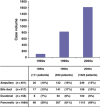2564 resected periampullary adenocarcinomas at a single institution: trends over three decades
- PMID: 23472829
- PMCID: PMC3892319
- DOI: 10.1111/hpb.12078
2564 resected periampullary adenocarcinomas at a single institution: trends over three decades
Abstract
Objective: This study was carried out to determine relative survival rates and trends in outcomes in patients who underwent resection of periampullary adenocarcinomas (PACs) with curative intent at a single institution over the last three decades.
Methods: From 1980 to 2011, 2564 pancreaticoduodenectomies (PDs) were performed for PACs. Pathological diagnosis, therapy and survival were retrospectively analysed.
Results: The primary sites included the pancreas (66%), ampulla (16%), bile duct (12%) and duodenum (6%). Operation volume increased from 11 per year in the 1980s to 135 per year in the 2000s (P < 0.001). Patients in the 1980s were younger (median age: 64 years; range: 33-90 years) than those in the 1990s (median age: 68 years; range: 31-103 years) and 2000s (median age: 68 years; range: 24-93 years) (P < 0.001). Over time, the frequency of a diagnosis of pancreatic cancer arising from intraductal papillary mucinous neoplasm increased from 2% in the 1980s to 8% in the 2000s (P < 0.001). The rate of 30-day mortality after surgery in the 1980s was 2%, which was similar to rates in the 1990s (1%) and 2000s (1%). Survival in each type of PAC did not change over time. Pancreatic cancer was associated with the worst survival (median survival: 19 months) compared with adenocarcinomas of the ampulla (median survival: 47 months), bile duct (median survival: 23 months) and duodenum (median survival: 54 months) (P < 0.001).
Conclusions: There are significant differences among PACs in longterm survival following PD. Although the numbers of patients undergoing safe resection have increased, overall longterm outcomes have not improved significantly.
© 2013 International Hepato-Pancreato-Biliary Association.
Figures



References
-
- Sarmiento JM, Nagomey DM, Sarr MG, Farnell MB. Periampullary cancers: are there differences? Surg Clin North Am. 2001;81:543–555. - PubMed
-
- Jemal A, Siegel R, Xu J, Ward E. Cancer statistics, 2010. CA Cancer J Clin. 2010;60:277–300. - PubMed
-
- Riall TS, Cameron JL, Lillemoe KD, Winter JM, Campbell KA, Hruban RH, et al. Resected periampullary adenocarcinoma: 5-year survivors and their 6- to 10-year follow-up. Surgery. 2006;140:764–772. - PubMed
Publication types
MeSH terms
Grants and funding
LinkOut - more resources
Full Text Sources
Other Literature Sources
Medical
Miscellaneous

